World
The cannons of Boston

South African Lindsey Parry was one of the 23,000 runners in the 2013 Boston Marathon. For runners like Parry, it should have been the crowning moment in a journey of commitment, hundreds of hours of training, and a collection of tattered running shoes. Instead, there was carnage. By GREG NICOLSON.
Two hours and 54 minutes – that’s the time that got Lindsey Parry to Boston. Eighteen months ago he and his friends decided they wanted to run one of the big city marathons. To qualify for races like the New York Marathon you can enter a lottery or raise money for charity, but to run Boston, those famed 42.2km to Copley Square, you need to qualify. The certainty appealed to Parry – run fast and qualify or run slow and miss out – so he decided that the Boston Marathon would be his city race.
For five or six days a week, he trained with friends. Once a week they would go for a long run – 36 to 45km. Every Wednesday they went through Parry’s favourite route through Bryanston “over really big hills to make us strong”. Perry ran the Comrades, Durban’s 87km ultra-marathon, with his friends but, unlike them, his main target was the Boston event in April. For more top-end speed he spent sessions on the track and in the hills.
In December 2011, Parry came 27th in the Aspen Port Elizabeth Marathon in a time of 2:54:46. It gave him a good position in the field in Boston on 15 April 2013. “It was an amazing day,” he told Daily Maverick from his room at the Liberty Hotel in Boston.
“As soon as you cross the start that’s when you start,” said Parry, meaning whether you’re number one or 1,000, the clock begins when you cross the start line. Parry is coach of the South African triathlon team and Comrades and heads the physiology lab at University of Pretoria. He sounded tired over the phone and the conversation was rushed.
“The route was stunning,” he remembered, “The people and support was like nothing I’ve ever seen before.” Over the first 35km the crowd was always at least two people deep and up to 10 people deep. In the last 7km Parry reckons it was 40 people deep. “The noise was so loud it felt like you were at a Test match.”
Having trained on South African circuits, the Boston route seemed easy to Parry. But the excitement got to him and he confesses he went too hard at the beginning. The last 5km were a grueling slog. He didn’t think about his Bryanston route or the sessions on the track; Parry, a columnist for Runner’s World, thought about the amount of training he had done as a collective. The Comrades was the best preparation he could have done, he thought when his quadriceps got sore.
“It was probably the single best race I’ve run.” He finished the 42.2km route in 2:47:46, a personal best by five minutes. “Then, two hours later, it all went wrong.”
Two large explosions only metres from the finish line instantly marred the experience of thousands of runners like Parry. It should have been the crowning moment in a journey of commitment, hundreds of hours of training, and a collection of tattered running shoes. Instead, the violent footage of the carnage at the 2013 Boston Marathon has become the moment of a generation. Like 9/11, the Western media’s dominance means images of bloodied victims and valiant police and volunteers have been relentlessly broadcast across the English-speaking world.
Three deaths have been recorded and over 140 people were injured. Ethiopian Lelisa Desisa won the men’s race in a time of 2.10.22 with Kenyan Rita Jeptoo taking the women’s race in 2:26:25. But it’s 8-year-old Boston resident Martin Richard who is likely to be most remembered from the 117th edition of the race.
“Richard was fatally injured and his mother and sister seriously wounded as they waited for their father and husband, Bill Richard, at the finish line on Boylston Street friends said. Bill Richard was active in the Ashmont community issues,” reported The Boston Globe. The US media is running a stream of stories about the fear of unknown attackers, the chaos of losing and finding loved ones, work closures, emergency protocols, and Copley Square, cordoned off as a crime scene.
The names of the other two fatalities have not been publicly identified and there are many questions still to be answered. (In the meantime, the second victim was identified as 29-year old Kristle Campbell – Ed) “We will find out who did this and we will hold them accountable,” said President Obama. “Make no mistake, we will find out who did this and why they did this, and the groups or individuals responsible will feel the full weight of justice.”
Parry was sitting in a bar when he heard a “cannon” go off at 14:50. He thought it was meant to mark a milestone, similar to some other races he’s been attended. Thirteen seconds later he heard it again. “That’s not a cannon. That’s not a cannon,” someone said. The first explosion is thought to have come from a bomb in a garbage can. A haze of smoke lingered as pandemonium ensued. Parry says people bashed down the race barriers. “The funny thing was, people were running towards the noise, not away from the noise.”
“It was quick – two minutes,” he says of the chaos. He saw people being carried on gurneys, pushed in wheelchairs, some with “disfigured arms”. Security and police officials were trying to find out what was going on. They were looking for a discarded bag, possibly a potential third bomb, but after everyone fled so many bags were discarded. Horrific and harrowing photographs by journalists who arrived for a sporting event illustrate the carnage.
Parry is due to fly back to South Africa on 22 April and has mixed feelings. “I feel sad,” he said, but his thoughts are with his father, a 64-year-old who can still run a marathon in three-and-a-half hours. “When I finished this race all I wanted was for my father to come… I would still want him to experience it.”
The stress of running for three-and-a-half hours alongside his dad, worrying whether there will be another attack, means he won’t bring his father, at least not next year. Maybe they’ll go in two or three years when Parry is confident it’s safe, when Boston can honour the lost without fear for the living. “They won’t forget what happened. The memories will remain but the fear will pass,” said Parry. That’s when he’ll bring his father to the Boston Marathon. DM
Read more:
- Boston combs mile-square after crime scene blasts in New York Times
- Photos of the Boston Marathon bombing in The Atlantic
Photo: Boston Marathon runners Lisa Kresky-Griffin and Tammy Snyder (L) embrace at the barricaded entrance at Boylston Street near the finish line of the Boston Marathon in Boston, Massachusetts April 16, 2013. Two bombs packed with ball bearings tore through crowds near the finish line of the Boston Marathon, killing three people and triggering a massive hunt for those behind an attack the White House said would be treated as “an act of terror.” REUTERS/Shannon Stapleton



















 Become an Insider
Become an Insider